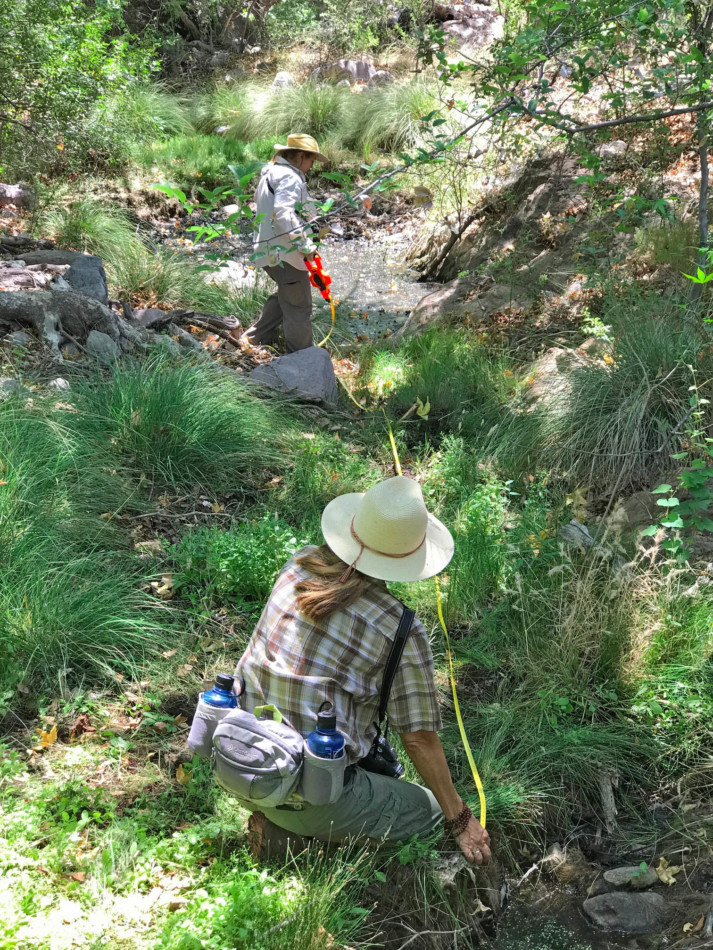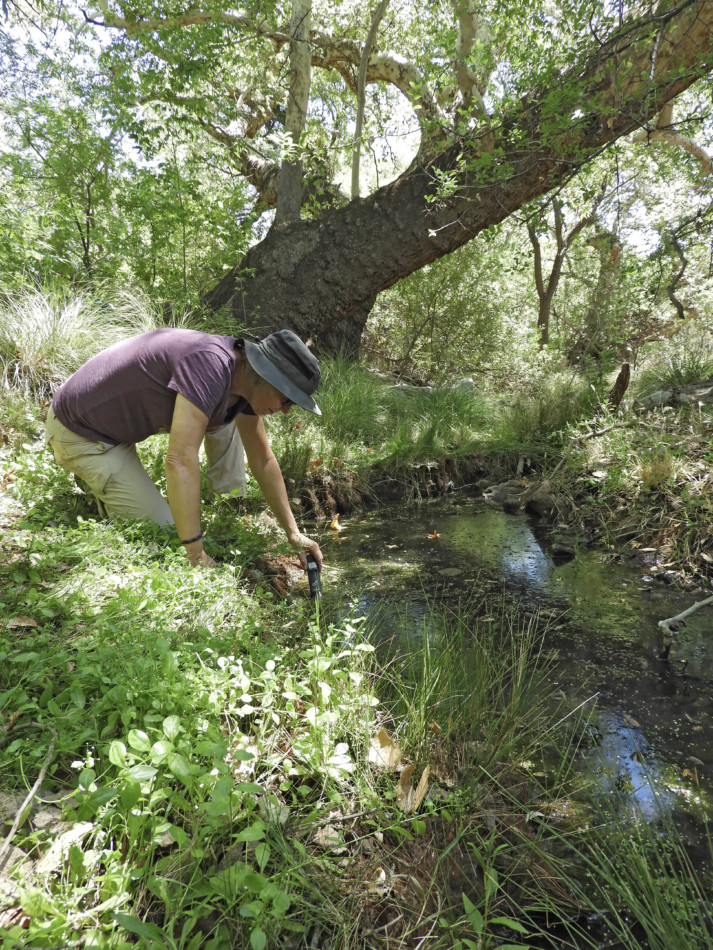by Valarie lee James, Sky Island Alliance Adopt-a-Spring volunteer
Sky Island Alliance Volunteer Log
Our First Visit to the Spring: Summer 2017
Note to the Reader: the whereabouts of this wilderness spring is not revealed to ensure the survival of its unique ecosystem.
Deep in a mountain range in southeastern Arizona, dry summer grasses flanking the border of Mexico, a ribbon of healthy green bewilders the eye. We are approaching a lush and life-saving spring hidden in a moist ravine.
Our guide, Sami Hammer, Conservation Biologist & GIS Specialist at Sky Island Alliance, leads us up and over a ridge line to the green ribbon below. We traverse the side of the cliff, stumble over craggy rock and slip on dry scrub-grass, then slowly circle down into the ribbon of green. At the bottom, we duck under barbed wire and into National Forest.
As newly recruited volunteers for the Sky Island Alliance’s Adopt-a-Spring program, my partner and I are thrilled. We have signed on to monitor the health of this spring, one of thousands, many still undiscovered, scattered throughout Arizona, one of the driest states in the union.
Once every season for the duration of one year, we will visit the spring. We will measure the width, breath, and depth of the spring, take water samples and measure flow, observe and document plant and animal species, tracks and scat.
Natural springs provide the biological and species connectivity throughout Southeastern Arizona and Northern Mexico critical for the survival of species in our deserts. The health of a spring’s ecosystem also provides with us crucial information about climate change and how it’s affecting the region.

A view of “our” spring
photo by the author
“Smell the sycamores yet?” asks Sami.
Taking our eyes off our feet, we find ourselves gazing on a raft of trees. We cross a wet meadow carpeted in lime-colored green grass and duck under massive sycamores. We smell the subtle, newly defined scent and feel the ambient temperature dropping markedly from the 100 + degrees in the sun to a cool mid-80’s.
My eyes follow the tree limbs up and into a flushed canopy of rustling leaves. The tree’s immense and ancient limbs curl over and drop-down, like great matriarchal arms, shading, protecting, and shielding the waters within.
Outside of lots of natural deadfall, the area is pristine. There are surprisingly few tracks or scat to speak of here, no signs of cattle, no people, only one javelina track and a bit of deer scat.
Walking the length and breadth of the area of the spring on a cushion of leaves, we pass large stands of Deer grass, a desirable native grass common to areas where there is shallow ground water. Sami also points out other wetland grasses and sedges as we pass: Bull grass, a fluffy headed native, and a non-native invasive grass Sami identifies as Red Bromegrass, a well-established threat to the Sonoran Desert.
Along with the sycamore trees, we see cottonwood trees, and large walnut trees, indicators of shallow ground water. An old stand of wild grape vines, as thick as my wrist, forms an arch from one old walnut tree to another, reminding me of the children’s book “The Secret Garden.” The air is fragrant with scent emanating from the walnut trees.

Sami takes note of spring conditions.
photo by the author
“It feels like a sanctuary, doesn’t it?” Sami says. Overwhelmed, I can only nod.
She identifies song birds: Summer tanagers, towhees, flycatchers and wrens flying in and out of the canopy, calling and singing.
At the top of a vertical drift we find the first small spring pool, surrounded by seep willow. Sami points out a whitish cast on boulders: residual salts and minerals, the tracks and scats of receding spring water. One of the boulders sports a camouflaged Canyon tree frog, as still and gray as the stone it straddles.
Water in the shallow spring pools is carpeted with honey bees and wasps buzzing like mad, and four different species of butterflies: A Black Swallowtail, a monarch-like queen, a pale yellow Lyside Sulphur, and an anonymous moth-like brown butterfly.
Bright orange Flame Skimmer dragonflies dart over the water in tandem with tiny near-translucent blue Springwater Dancers: dragonflies and damselflies are surely the Fairies of old in this secret garden.
“It’s like a wonderland” I say. My words sound hollow as soon as they spill out of my mouth. I have no words. No words for this Sonoran Eden, an Eden before the fall.
Finding flow
My partner Steph was the first to see it: water flow and only after she took a second look. Impossible to spot at first glance, flow was happening deep inside a narrow crack running through a rock outcropping that separated two small pools.

Valarie and Sami measure the extent of the spring
photo by Steph Stayton
We are avid hikers in Southeastern Arizona. The few times we discovered water in the desert I returned home feeling wholly graced, supplicant to the miracle of water in the desert. This was no exception. I dropped to my knees.
“This is Great!” Sami exclaimed. I didn’t think I’d get a chance to show you now, in June, how to measure flow.”
The connecting channel was partially obscured with organic material and mud. Kneeling also, Sami cupped her hand and gently scooped out earth and leaves and tiny branches. She then laid a piece of PVC pipe into the channel water flowed steadily out the front end of the pipe, like a garden hose.
We filled up a plastic bucket, then filled it again. Steph measured volume and temperature. The water was a temperate 77 degrees, appropriate to water flowing underground in the desert.
“It turned out to be a significant flow.” Steph said, smiling. “Bright highlights dancing on the surface of the water indicated movement of water below.”
The water had a pale sepia cast and smelled slightly of sulfur but was otherwise clear. We wondered if this good rich smell was due to tiny particles of organic debris in the water or a hot spring somewhere along the course.

Steph measures water quality
photo by the author
Seeing the volume of water in the bucket, everything in me wanted it: my tongue, my skin, my eyeballs. I wanted to be immersed. I wanted to drink it in long draughts like the bees and the butterflies and all other creatures that frequented the spring.
Of course, I knew I dare not unless the water was purified, though if I had to, I would. A single tattered plastic bottle at the edge of one of the pools was evidence that someone else had also thirsted at this spring long ago. A hand-woven Mexican blanket nearby, now tamped down in soil and covered in decayed plant matter, had become part of the earthen fiber of this place.
I wondered: Had they sheltered there at the spring? Had he seen deer or coatimundi in the still of the night? Could she have witnessed Ocelots or even Jaguar at the water? Could any creature, two-legged or four-legged, winged or scaled, part from the call of water?

